
Grand entrance: The main gate is much grander than the Bazaar itself (All photos: Ali Fraz Rezvi)
Meena Bazaar, one of the oldest markets in the walled city, a market that was once run exclusively for women, by women, does not have a single female shop owner today.
The bazaar was originally located at Delhi Gate and later shifted to its present location near Jama Masjid.
The origin of the bazaar can be traced back to the reign of Emperor Akbar, when it used to be a week-long event organised around the Persian new year Navroz. Later, when Shahjahan shifted his capital to Delhi, Meena Bazaar was re-started by his most beloved wife, Mumtaz-uz-Zamani Arjumand Bano Begum alias Mumtaz Mahal.
As time passed and the Mughal empire waned, the bazaar lost its sheen.
Today, it has been reduced to a cluster of a few concrete structures and hundreds of big and small makeshift stalls. Items such as clothes, footwear, groceries, crockery, showpieces, wall hangings, food items and daily-use objects, are on offer here.
“This isn’t the original Meena Bazaar”, says Mohammad Naseem, a 62-year-old vendor sitting at the entrance gate of the market.
“I was 12 when I used to accompany my father from our residence at Baradari Ballimaran to the stairs of Jama Masjid, where he used to sell hand-made items of daily use. Later, in the mid-1960s we were relocated to Khas Bazaar behind Jama Masjid, which was then renamed Meena Bazaar.”
“I was here when the market was locked on the orders of Sanjay Gandhi during the Emergency and later relocated with a few properly constructed shops only because of the efforts of Fakhruddin Ali Ahmad, the then President of India”, Naseem said.
“We have seen this market waterlogged during monsoon and this state of neglect will probably not change”, added a paan shop owner.
Chaman, owner of one of the stalls here for the past 20 years, says, “Sales have been dropping with each passing day.” He told Patriot that all redevelopment plans are made keeping in mind the interests of the big shop owners, whereas the smaller players like him are ignored.
“The government has never done anything for us other than kicking us out of this market despite a stay order from the Supreme Court back in 2015. I don’t expect anything else from them either”, he adds.When one walks through the lanes of Meena Bazaar, one encounters nothing historical except the walls and stairs of Jama Masjid, the mausoleum of Abul Kalam Azad and a shallow channel running through the length of the market, along which, perhaps, a small stream must have flown once.
There is nothing historical about Meena Bazaar other than its name, says writer and historian Sohail Hashmi.
He tells Patriot that it is undeniable that the market is largely ignored by the authorities, as reflected in the list prepared by the Delhi government for the first phase of redevelopment in which five markets, including one in Khari Baoli, were selected.
“Most of these markets are situated outside the walled city except Khari Baoli, which provides spices, pulses and grains to more than seven Indian states”, he said.
According to Hashmi, the redevelopment project of the Delhi government would have done to Meena Bazaar what it intends to do to Khari Baoli – ‘an outer beautification and nothing else’ – something that has already been done to Chandni Chowk.
At a time when the Delhi government and the MCD are gentrifying markets, one can only hope that Meena Bazaar will not wither away with time.
For more stories that cover the ongoings of Delhi NCR, follow us on:
Instagram: https://www.instagram.com/thepatriot_in/
Twitter: https://twitter.com/Patriot_Delhi
Facebook: https://www.facebook.com/Thepatriotnewsindia
The four cases are linked to the land-for-jobs and IRCTC scam, which are being probed…
This was followed by the Delhi Development Authority (DDA), which addressed 4,804 of the 5,197…
These local stores stock thicker jackets, practical sweaters, and everyday layers that are designed for…
Veer Ahlawat’s final-round 67 sealed a three-shot win at the Rs 1 crore CIDCO Open…
OnePlus has launched the 15R smartphone and Pad Go 2 tablet in India, with prices…
Nearly 2,800 Delhi vehicles denied fuel on first day of 'No PUC, No Fuel' drive…